AQUABOX
High capacity modular system for stormwater retention, infiltration, disposal, or reuse

It was designed for fast installation, fully inspectable and suitable for both landscape and traffic areas, following the standard parameters of Sustainable Drainage Systems. Aquabox is an underground plastic module in which water is collected and stored. The aim of this system is to collect the rainwater temporarily and release it with a time delay into the sewage infrastructure, preventing flooding in urban areas.
The storage space is created by a multitude of Aquabox elements, which can be combined to form plants of any size. The advantage of this method is that with this infiltration system, the cavity volume is up to 3 times larger than gravel ditch and thus space and excavation can be saved.
Stormwater retention and infiltration system created with Aquabox provides efficient flood protection both for the natural and built environment. This way, the system also prevents damages and further remediation costs, justifying the profitability of the overall investment.
Solutions
- HOUSEHOLD USE RAINWATER HARVESTING
- IRRIGATION OF PUBLIC PARKS
- WATER STORAGE BASIN FOR REUSE
- RETENTION BASIN
- STORAGE AND DRAINAGE BASIN
- INDUSTRIAL AND COMMERCIAL AREAS DRAINAGE
Advantages
- EFFECTIVE WATER DISPERSION WITH REDUCED EXCAVATION DEPTH AND REDUCED VOLUMES COMPARED TO TRADITIONAL SYSTEMS
- 96 % WATER RETENTION CAPACITY SIGNIFICANTLY HIGHER COMPARED TO DISPERSING GRAVEL LAYERS AND PERFORATED PIPES
- 100 % INSPECTABLE AND APPROACHABLE FOR CLEANING
- LIGHTWEIGHT MODULES
- FAST AND EASY INSTALLATION
- SAVES STORAGE SPACE
- SLW 60 CLASS LOAD CAPACITY
- VERSATILE
- MADE OF RECYCLED POLYPROPYLENE
- APPLICABILITY EVEN IN CASES OF VERY HIGH UNDERGROUND WATER
Aquabox Video
Installation Scheme



How to build an Aquabox basin in 7 easy steps
Aquabox was engineered for a fast and easy manual setup. Thanks to its snap-fit locking system and 10 kg weight, it can be installed even by inexperienced workers. Here is a beginners guide on building an Aquabox rainwater basin in 7 easy steps, based on our recent project in the coastal town of Punta Ala, Italy. Step 1 Make the bedding Dig a trench and level the soil. Line it with geotextile (for infiltration basins) and, if needed, geomembrane and 2nd layer of geotextile (for retention and reuse). Step 2 Unload the pallets Aquabox is delivered stacked for easier transportation. Each pallet carries 80 half-elements or 40 modules. Step 3 Make the modules Unpack the pallets and join the half-elements together to create Aquabox modules. Step 4 Place the modules Assemble the basin by placing the modules and locking them together with red connectors. Step 5 Place the grid Close the basin by placing sidewall and top grids. Step 6 Cover the basin Cover the basin with geotextile. Seal it with a geomembrane and 2nd layer of geotextile, if needed. Cover with soil. Step 7 Enjoy Enjoy the great rainwater management from your new Aquabox basin.
Top 10 advantages of Aquabox over gravel
Sand, gravel, and crushed stone are the most mined minerals on Earth. They are unsustainably sourced and reliant on massive amounts of transportation, which destroys local ecosystems and increases CO2 emissions. Aggregate use has also intensified by over 60 % in the last 20 years, although we have better solutions at hand. Aquabox offers at least 10 advantages: Sustainably made Gravel is a virgin material that has to be extracted from the environment. Aquabox is made of recycled plastic that is both reusable and 100 % recyclable. Less storage space Gravel is difficult to store on worksites and has to be frequently restocked because of its massive volumes. One Aquabox pallet takes 3.14 m3, which can be unpacked into a 36 m3 basin. Less transportation Gravel requires vast amounts of transport, adding to the 6 % of CO2 emissions coming from heavy-duty vehicles. Aquabox is light, stackable, and takes 75 times fewer truckloads for the same-sized basin. Less machinery Gravel requires mechanical lifting and compacting equipment. Aquabox can be installed by individual workers, by simply placing and locking the elements together. Fast installation By reducing the need for heavy machinery, Aquabox allows better worksite productivity and decreased installation time, especially in small worksites surrounded by traffic. 3 times better efficiency With a 96 % retention capacity, Aquabox holds 3 times more water than gravel, which makes it 3 times more efficient in improving flood resilience. Reduced basin volume With 3 times smaller excavation volume, Aquabox saves space in congested urban environments and reduces worksite labor, machinery, and time. Easy maintenance While gravel is not approachable for cleaning, Aquabox is 100 % inspectable, allowing easy maintenance during the basins life cycle. Versatility While gravel can only be used for infiltration, Aquabox can also be used for water retention and harvesting for reuse. Health safety Gravel basin efficiency depends on the quality of surrounding soil and can be prone to stagnating water buildup. Aquabox offers more control, keeping the collected water underground, away from outside conditions.
Aquabox installation efficiency beats gravel and concrete
Aquabox installation efficiency beats gravel and concrete because it is made of lightweight recycled plastic. This takes away all the dirty work from stormwater basin construction: concrete production, truckloads of material, storage space, mechanical equipment, heavy lifting all gone. Assembling your Aquabox water basin takes 5 easy steps: Step 1: Make an excavation of a desired surface and depth, line it with geotextile. Step 2: Unpack the pallets and assemble Aquabox modules. Step 3: Place and lock the modules together to form a stormwater basin. Step 4: Attach the top and side grids to close the basin exterior. Step 5: Wrap the basin with geotextile and cover it with soil.
Why we use recycled plastic in construction?
Recycled plastic is perfect for construction. Since 1998 we have been using it to improve the sustainability and profitability of the construction process. Here is why it is in many cases better than concrete, metal, wood, and many other materials: Sustainability Plastic waste can be recycled and used for the manufacturing of new products.Example: Circular production is one of our main goals, which is why 95 % of our products are made of recycled plastic. Lightness Plastic is lighter than wood, metal, and concrete, demanding less mechanical equipment, machinery, and manpower, which improves building speed.Example: Geotub weighs only 4 kg, offering 44 % better speed performance in the casting of round columns even compared to cardboard. Flexibility Plastic can be easily molded into any shape on an industrial scale compared to metal and wood, which makes it suitable for multiple tasks, from concrete casting and water infiltration to grass protection.Example: Aquabox has a grid-like surface designed to prevent dirt and soil from entering the basin, allowing easy future maintenance of the stormwater system. Strenght Plastic has high load resistance and can carry the weight of concrete, water, or heavy vehicles.Example: Runfloor can carry a weight of over 600 tons per m2, allowing vehicle access across the grass and unstable soil. Durability Plastic products are durable and therefore reusable, making construction less costly and leaving less waste on construction sites.Example: Geopanel and other Geoplast plastic formworks can be reused 100+ times, compared to 12 to 20 uses of plywood.
Aquabox takes 75 times fewer truckloads than gravel
Both Aquabox and gravel are used for rainwater management. Unlike gravel, however, Aquabox is significantly easier to transport, which makes it considerably more profitable and sustainable. Gravel is one of the most commonly used draining materials because it is widely available and simple to handle. It is also heavy and bulky, demanding significant amounts of transport, which only adds to the building costs and the 6 % of total CO2 emissions that come from heavy-duty vehicles. Aquabox, on the other hand, has none of the issues of its counterpart. It is made of recycled plastic modules that are lightweight (max 9 kg) and designed to achieve maximum packing density. In comparison: 450 m3 rainwater basin Gravel Aquabox No. of truckloads 75 1 Only 1 truckload of Aquabox is needed to build a 450 m3 stormwater management basin, as opposed to 75 truckloads of gravel. Thanks to its material and innovative design, Aquabox offers significant logistical advantages, considerably increasing the profitability and sustainability of construction projects.
How can architects improve urban resilience to the climate crisis?
Extreme weather events caused by global warming are increasing in frequency and intensity, making resilience improvements urgent in urban areas. Between net-zero challenges and the inert building industry, architects are in the hotspot of finding effective and sustainable solutions for their projects. We have engineered a range of solutions to help the architects build more resilient cities, and they are ready to be used as early as tomorrow: Improving surface permeability with grass and gravelOne of the biggest problems of city growth is impervious asphalt surfaces intensifying the already critical issues of flooding and urban heat islands. Using grass and gravel whenever possible is paramount for improving the natural drainage of the soil in urban environments. Geoplast has developed several recycled plastic flooring systems such as Geoflor, Geograss, Runfloor, Salvaverde, and Geogravel that architects can use to convert the existing or create new permeable areas for pedestrian and vehicle access in a matter of hours. Mitigating floods with efficient stormwater managementProjects that rely solely on the old city sewers for stormwater management are no longer a viable option. Recent flooding events have urged the need for more efficient and sustainable solutions able to enhance the existing sewer systems or function independently of them. Underground basins created with Aquabox, New Elevetor Tank, Drening, and Drainpanel, along with the surface drainage systems such as Geocell, are designed to successfully manage the rainwater influx under buildings and paved areas, and enable water harvesting for irrigation, household purposes, or fire protection. Reducing urban heat islands with green roofs and wallsGreen walls and roofs act as a natural thermal shield able to reduce the buildings energy requirements by 43 %. If applied to each new project, they can also lower the temperature of local neighborhoods, reducing the effect of the urban heat island. Wall-Y is designed for creating green walls, while Drainroof and Completa are used for growing extensive or intensive roof gardens. Each is well suited for city conditions in terms of technical, maintenance, and aesthetic requirements, enabling a more resilient energy and temperature management.
Aquabox stormwater management at Milan Bergamo Airport
The number of passengers at Milan Bergamo Airport grew by 14 times since 2003, hitting the record-breaking 13 million by the end of 2019. In an effort to improve the service, the airport invested 435 million in its 2030 development plan. The first phase was the 70,000 m2 East terminal, scheduled for opening in April 2020. We were approached by Milesi Geom. Sergio construction company with the problem of engineering a high-capacity stormwater dispersion basin that would serve the airports infrastructure areas. The existing terminals remained operational during construction, so along with the basins efficiency, the building speed was vital in maintaining as little disruption as possible. Solutions such as concrete pipes and wells were weighing several tons, which made them difficult to handle and transport. Gravel, on the other hand, demanded large excavation depths and volumes in order to provide efficient drainage. Our experts suggested Aquabox: it was modular, lightweight, stackable, and exceedingly faster to install, taking dozens of truckloads less to transport. It was also recycled, high load-bearing, 100 % inspectable, and had 96 % retention capacity, coming forward as a far more efficient and sustainably profitable solution than the alternatives. Aquabox was our newest product at the time, announced just months before, but was recognized as perfect for the task, getting the immediate application in the field. The basin was built with a 270 m3 capacity (14.25 x 13.50 m surface and a 1.4 m height) by using 2,704 Aquabox and 64 Aquabox Cube elements.
6 Aquabox innovations for water management
Aquabox is our newest water product designed in 2020 with the goal to further improve rainwater management and flood resilience. The latest technologies and engineering trends that were used in its development give it 6 powerful features, that set it apart from the traditional water management systems and present-day competition: 100% inspectable Aquabox modules are easily inspectable and approachable for cleaning, so that you can check the condition of the basin anytime during its life cycle. 96% water retention capacity Aquabox is made of hollow plastic that can hold 3 times more water than gravel, crushed stone or perforated pipes. High load bearing capacity The SLW 60 load-bearing class makes Aquabox suitable for green or pedestrian surfaces, as well as areas subjected to heavy vehicle traffic. Light weight and fast installation Aquabox modules can be lifted, manipulated, and installed manually, by individual workers, which improves productivity and reduces the need for heavy machinery on site. Less storage space Aquabox elements are modular and designed to fit perfectly together. This reduces the volume of storage space, which can be particularly important for small or inaccessible worksites. Sustainability Aquabox is highly efficient in the reduction of surface runoff and the preservation of the natural water cycle, which greatly improves the resilience and sustainability of urban spaces.
Aquabox Calculator is available online
Aquabox Calculator is Geoplasts new online tool developed for estimating the amount of Aquabox elements needed for your project. Based on the design parameters you enter, such as geometrical data, the kind of traffic load, and number of inspection shafts, the calculator suggests: Aquabox product features (weight, height, length, and surface),Structure dimensions (storage volume, tank dimensions, infiltration surface),Bill of material (number of Aquabox elements and accessories).You can download the calculation report with all the input and output data in PDF format and, if you need further assistance, you can leave your contact and project information and our experts will contact you. Aquabox Calculator is free, with no registration needed, and available in English, Italian, French, German, and Spanish languages.
Aquabox is 100% inspectable
Aquabox is our latest rainwater management solution for water retention, infiltration, disposal, or reuse, which is 100 % inspectable. The internal configuration of the product is designed to be easily accessible for inspection, routine maintenance, and cleaning. The Aquabox solution allows the entrance of a small wheeled camera that makes a 360 video inspection of the basin in any direction and on all levels. Besides retaining 3 times more water than gravel, Aquabox solution is easier to inspect and unclog. The key point is to properly design and dimension an underground basin that is suitable to project requirements, built environment, local rainfall parameters, and characteristics of the soil. With the help of our experts, a correctly designed Aquabox basin will provide minimal dangers of clogging and the best possibility for maintenance.
Aquabox is 3 times better than gravel
Aquabox is 3 times more efficient product for rainwater drainage compared to gravel. Gravel was so far the best traditional solution for rainwater dispersion. In comparison with swales and trench drains, it does not require as much land surface and excavation. Also, it is environmentally more sustainable than dry wells made out of concrete. Aquabox Vs. Gravel Benefits Aquabox Gravel Water retention capacity 96 % 30 % Inspectability 100 % Not inspectable Delivery* 1 truck 75 trucks Construction site storage* 20 m3 1,500 m3 *Infiltration basin of 450 m3 volume. With96 % water storage volume, our Aquabox significantly surpasses the gravel efficiency of 30 %. Therefore, Aquabox can drain 3 times more water than gravel for the same basin volume. It allows uniform diffusion of stormwater in all directions, ensuring the absorption and slow release of water during intense rainfall with high flow rates. The modularity of Aquabox allows it to adjust to any basin shape, making it adaptable to congested urban areas. Since it is lightweight, stackable, and easy to install, Aquabox lowers transportation and installation costs in comparison with gravel and reduces traffic pollution. It saves storage space, making the construction work significantly more efficient than working with gravel.
With Aquabox you can afford Tesla Model 3
Homeowners can reduce home maintenance costs by managing rainwater with our Aquabox. Efficient rainwater drainage reduces the costs for infrastructure and water-related property damage, and rainwater harvesting lowers the bills for water and improves resilience. Example estimate of 200 m2 home ownership cost savings with Aquabox *: Lower bills for technical water in buildingsAquabox can be used for rainwater harvesting that saves the bills for non-drinking water purposes in the household: Washing machines;Sanitation and hygiene;Watering the plants;Irrigation of green areas and gardening;Washing vehicles. Mitigation of water-related damageAquabox system for rainwater infiltration and attenuation can prevent damage to the property caused by:Heavy rainfall: a significant amount of precipitation in only a few hours can lead to severe landslide risk;Floods: the most common risk for foundations and structural damage of the house;Water retention: endangers sidewalks, pavings, topcoats, etc. Decreased costs for maintaining infrastructureAquabox provides faster rainwater runoff, lowers dependency on the sewage system, and reduces the costs of maintenance of pavement threatened by damage from water retention. At the same time, repairing costs for clogged and leaking pipes of sewer lines can be prevented with an independent drainage system.








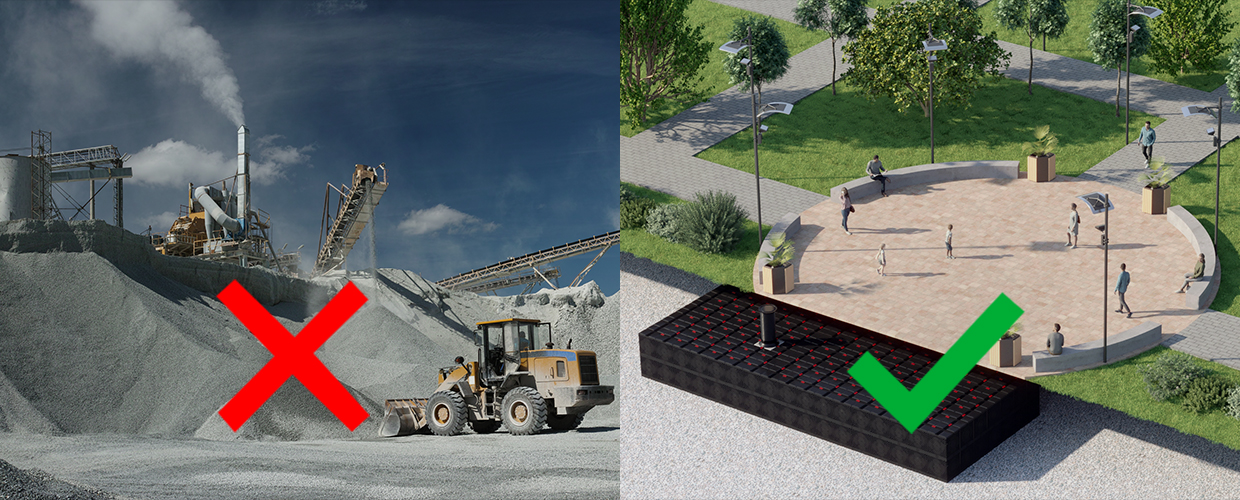
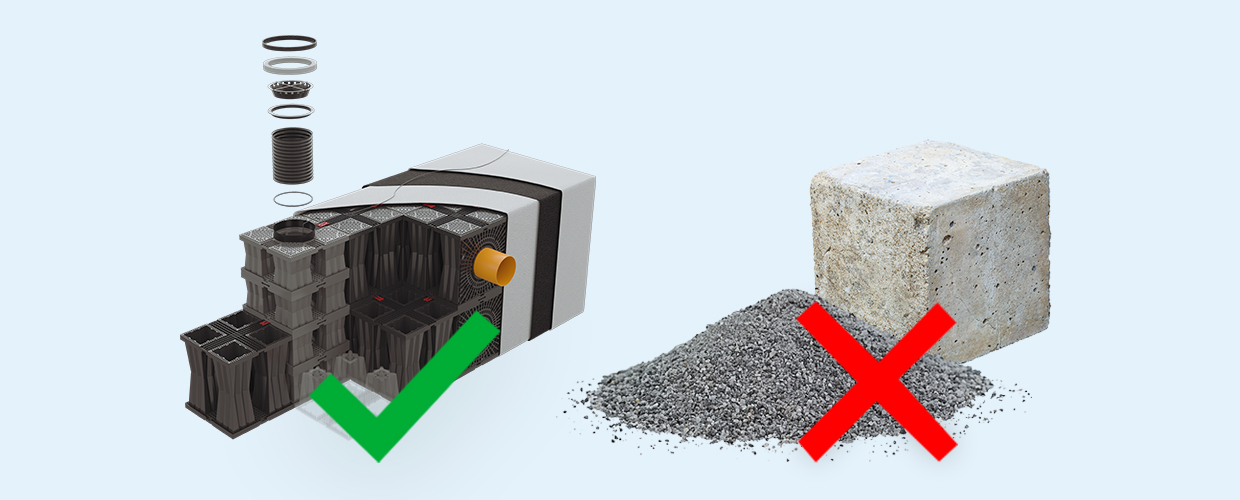




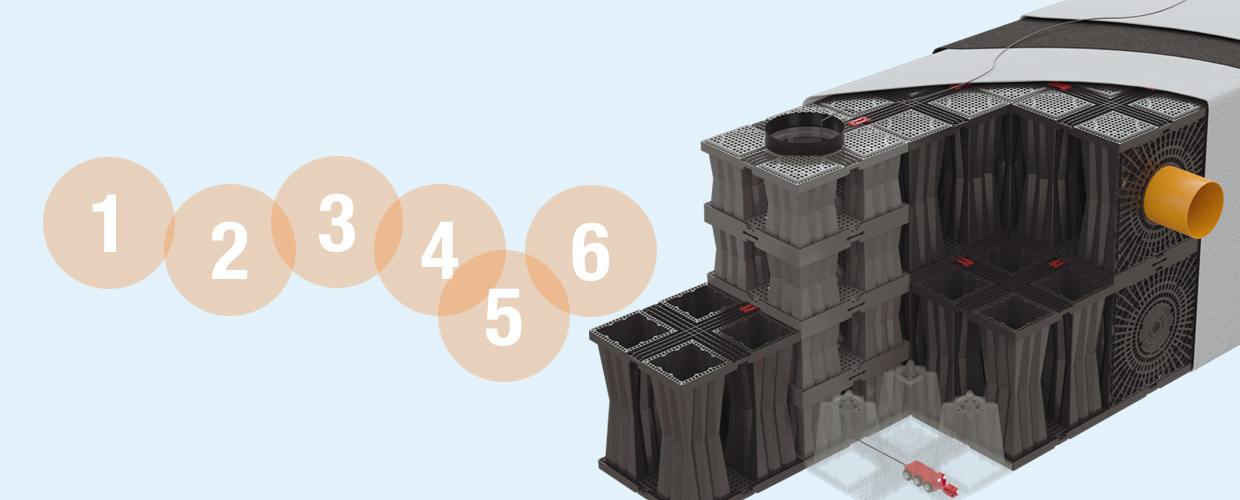
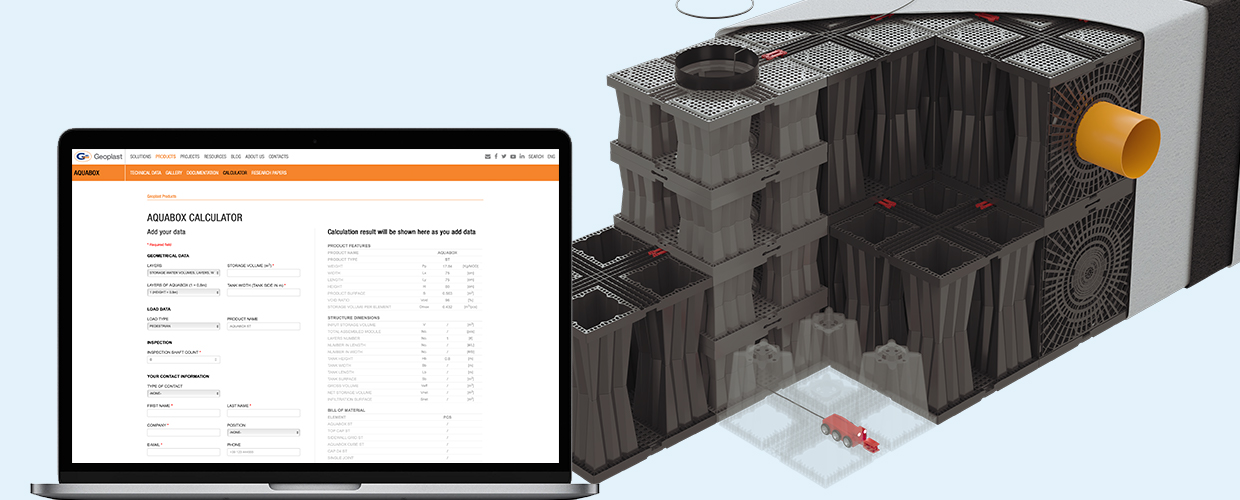
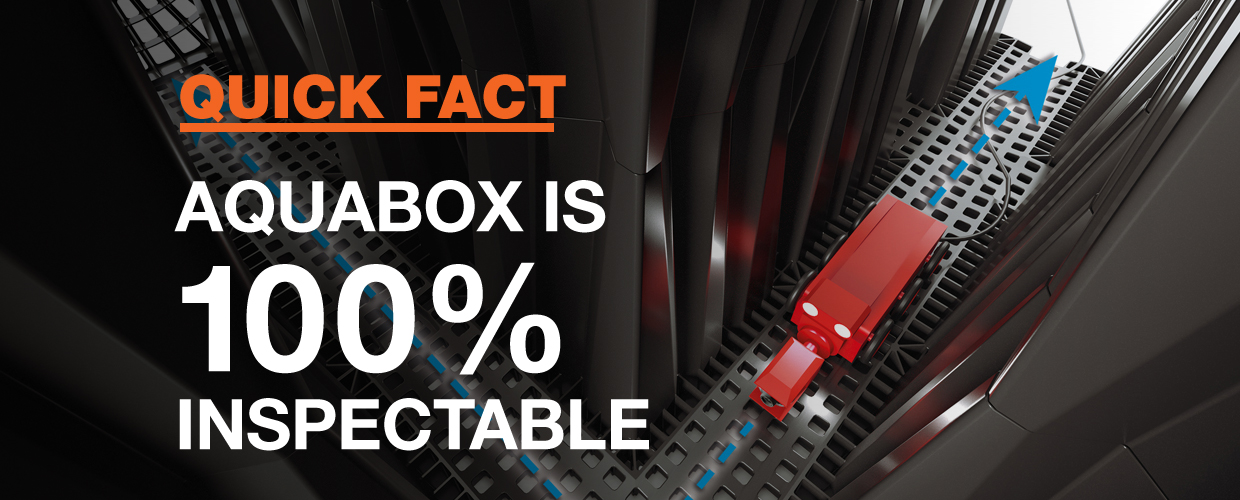
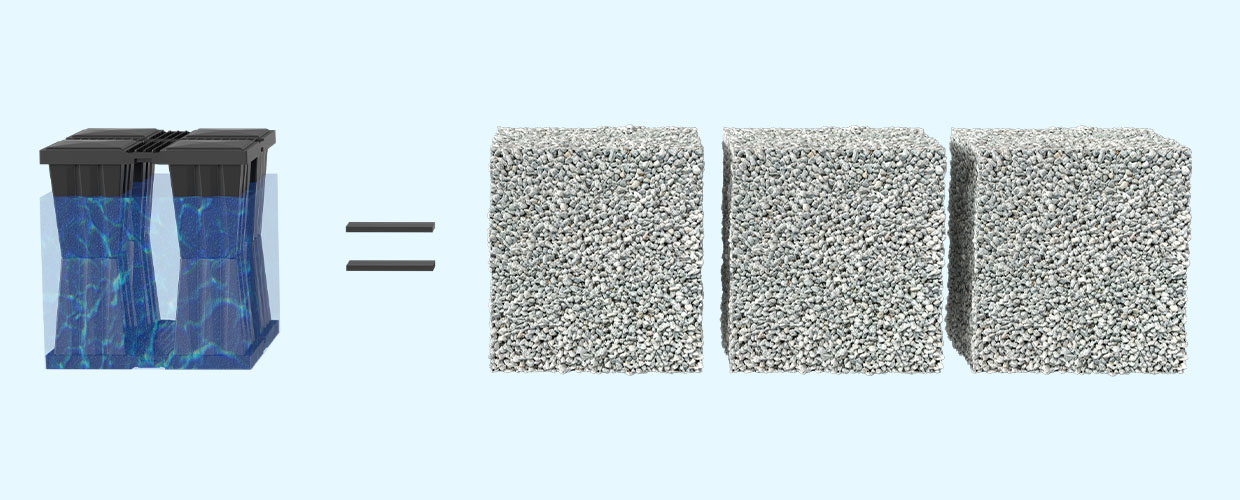


Content About the Product
ALL